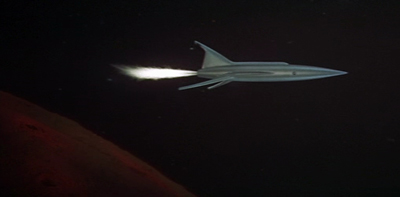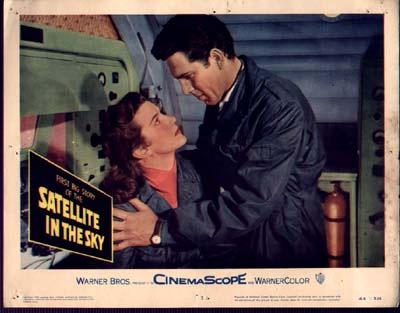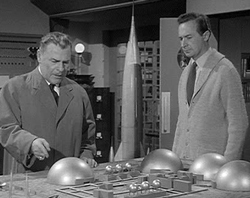| Release List | Reviews | Price Search | Shop | Newsletter | Forum | DVD Giveaways | Blu-Ray/ HD DVD | Advertise |
| Reviews & Columns |
|
Reviews DVD TV on DVD Blu-ray International DVDs Theatrical Reviews by Studio Video Games Features Collector Series DVDs Easter Egg Database Interviews DVD Talk TV DVD Talk Radio Feature Articles Columns Anime Talk DVD Savant HD Talk Horror DVDs Silent DVD
|
DVD Talk Forum |
|
|
| Resources |
|
DVD Price Search Customer Service #'s RCE Info Links |
|
Columns
|
 |
World Without End |

|
50s Sci-Fi Double Feature Warner Home Entertainment 1956 Color 2:35 anamorphic widescreen Street Date July 29, 2008 "Best Buy Exclusive" |
It looks as if Warners won't be returning this year with more Cult Camp Classics. Helping to ease the pain is a trio of Sci-Fi double bills rushed out the door to debut as Best Buy Exclusives. The first of these discs is a pairing of two fairly early Sci-Fi efforts from 1956. One is a quirky space 'n' time travel curiosity from Allied Artists and the other is an almost completely forgotten space opera produced in England. Filmed in CinemaScope and color, both may have been inspired by the success of Universal's Technicolor 1955 hit This Island Earth. For the rest of the 1950s filmed Science Fiction would be dominated by low budget B&W quickies made independent of the major studios.

|
World Without End 81 min. Starring Hugh Marlowe, Nancy Gates, Nelson Leigh, Rod Taylor, Shawn Smith, Lisa Montell, Christopher Dark, Booth Colman, Everett Glass Cinematography Ellsworth Fredericks Makeup Emile LaVigne Art Direction Dave Milton Film Editor Eda Warren Original Music Leith Stevens Produced by Richard V. Heermance Written and Directed by Edward Bernds |
World Without End is a real oddity. It was written and directed by jack-of-all trades journeyman Edward Bernds, a veteran of the B-picture industry. As that market imploded he fanned out into westerns, Sci-Fi teen exploitation and Three Stooges features. His movie relocates H.G. Wells' The Time Machine into a rocketship, but most of the screen time is spent within skimpy Allied Artists sets and location work at Stony Point in the NW corner of the San Fernando Valley. The 'exotic future society' on view isn't much different from lost kingdoms in adventure tales from the Arabian Knights to Tarzan movies, and the main theme is that we coddled Americans need to get tough and fight for our place in the sun. As an added thrill, Bernds' movie exploits the 'space babe' idea from groaners like Cat Women of the Moon. These futuristic pin-ups look great in abbreviated outfits designed by none other than girlie artist Alberto Vargas.
In his core study Keep Watching the Skies! fifties' Sci-Fi authority Bill Warren pegged World Without End's status as an inverted adaptation of the classic novel The Time Machine. This version's monstrous Morlocks enjoy the sunshine while the effete Eloi hide in caves. H.G. Wells' tale has an anti-war, humanistic message, whereas Bernds' screenplay alters the formula to celebrate the macho territorial imperative. Our gutsy astronauts teach the pacifist pansies of the 25th century how to get out there and kick ass.

The film's exiting posters and promo artwork promise the kind of delirious adventures featured on the covers of Sci-Fi pulp fiction, but the movie dispenses with its outerspace content in only eight minutes. Weak rocketship scenes (recycled, along with some rubber spiders, for AA's later Queen of Outer Space) give way to indifferent locations familiar from series westerns. In the underground city, the architecture in the three or four rooms we see favors plywood triangles. Colors are bright but Ellsworth Fredericks' lighting is flat and unexpressive.
The weak intrigues at court are offset by amusing boy-girl sparks. Hugh Marlowe immediately hits it off with comely Nancy Gates (Comanche Station, Some Came Running), who parades a stunning pair of legs in Vargas' cutesy-pie outfits. Shawn Smith beams happily at the sight of Rod Taylor's bare chest, and dark-haired Lisa Montell, playing a former slave girl of the Mutates, falls hopelessly in love with him as well. The rugged Taylor would play The Time Traveler in George Pal's version of H.G. Wells' original; we wonder if Taylor's bright attitude helped launch his star career with roles in Giant and Raintree County. The professor (Nelson Leigh, a "star" of now-campy civil defense shorts treating atomic war as an inconvenience) stays out of the running for female companionship, while the fourth astronaut Christopher Dark remains gloomy over the loss of his wife and children, left 500 years in the past.

To reestablish humanity topside where real estate means something, the four spacemen eventually fabricate a bazooka and go Mutate hunting; most of the action in the film is tame rock hopping and wrestling amid very ordinary surroundings. The Mutate make-ups are bizarre and disturbing, with bulging eyes and rearranged facial features, but they're seen almost exclusively in wide shots. The MPAA may have warned Allied Artists away from horror close-ups. It's more likely that Bernd's standoffish style (and the limitations of early CinemaScope lenses) kept the camera further back.
Speaking of CinemaScope, World Without End has been shown flat for over fifty years; this is its first disc release. The wide compositions no longer crop characters off screen but the 'Scope frame doesn't reveal anything particularly distinctive about the visuals. Edward Bernds' direction is mostly flat and static. The film's tagline reads CinemaScope's First Science-Fiction Thriller Hurls You into the Year 2508!, but MGM's Forbidden Planet seems to have beaten it into theaters by a couple of weeks. Maybe they aren't counting Disney's 20,000 Leagues Under the Sea, released more than a year earlier. 1
|
Satellite in the Sky 84 min. Starring Kieron Moore, Donald Wolfit, Lois Maxwell, Bryan Forbes Cinematography Georges Périnal, Jimmy Wilson Special Effects Wally Veevers Art Direction Erik Blakemore Film Editor Sidney Stone Original Music Albert Elms Written by John Mather, J.T. McIntosh, Edith Dell Produced by Edward J. Danziger, Harry Lee Danziger Directed by Paul Dickson |

|
It doesn't matter that Satellite in the Sky isn't very good; it has been largely unviewable for fifty years except on bad pan-scan bootlegs. Filmed in CinemaScope and color in England, it's also no cheapie. The shapeless script is hobbled by a great deal of just plain awful dialogue. Noted actor Donald Wolfit hams up his biggest scenes just to provide relief from the lack of drama or tension. Welsh director Paul Dickson had a fairly prolific career in Brit TV but the film's three writers share only a couple of other credits between them.
Variety's review (July 11, 1956) said that Satellite in the Sky "almost becomes an unconsciously funny comedy" due to a maladroit script and leaden direction. Future Miss Moneypenny Lois Maxwell didn't do well for her first English film after spending several years in the Italian industry. Her Kim Hamilton has no problem stowing away on the spaceship, and nobody seems very upset to discover that she's aboard. In Brog.'s words, "she spends her time in the stratosphere plaguing the crewmen with silly questions like, "Are you sure you know what you're doing?"

The film's 85 minutes are padded with footage of English jets landing and taxiing, courtesy of the A.V. Roe and Folland aircraft companies; one of the planes appears to be a Vulcan bomber as seen in the 007 film Thunderball nine years later. Director Dickson's talky scenes frequently contain only one or two cuts, and the film moves like molasses. The petty domestic subplots go nowhere.
Interest finally focuses on the flight itself, and the politics behind it. The English commanders express only token irritation to find out that their research mission is really a Cold War bomb test for Uncle Sam; the regular crewmen aren't even told they're going to lob a Tritonium Bomb from their airlock, and barely seem to care. The too-casual attitude is indicative of a slack and uncoordinated production. In one scene, a jet said to be thousands of feet in the air is shown to be literally buzzing the airfield. Commander Kieron Moore shoos some technicians out of the ship after the atomic rockets have started warming up and are spewing radioactive steam all over the launching bay. As the workmen go out the door, Moore advises them, "Oh, be careful of the radioactivity!"
Satellite in the Sky takes its cue straight from When Worlds Collide, with the ship launched up an inclined ramp at an angle of only 35° or so. The filmmakers have built some impressive spaceship interior sets, with double automatic airlock doors, etc. The miniature spaceship is a beauty, a standard streamlined dart shape that we first see sitting on an enormous cradle-slide in an underground hangar. The 'big reveal shot' is almost identical to the first reveal of the super-sub Gotengo in Toho's Atragon, except that this model is much more detailed. Individual metal panels stand out on the ship's silver skin. 2

Unfortunately, the model photography is mostly poor. The terrific underground view cuts with a completely mismatched matte painting. Our expectations rise as the ship tilts and giant doors open to reveal the ramp stretched out above. But the launch is botched by several angles that make the ship seem to go slower as it ascends the ramp. The final long shot then shows the ship zipping away up the track like a cheap skyrocket. The camera pans, but too late to see it leave the ramp! In the following shot the ship is barely off the ground, as if in imminent danger of crashing. Giant wires are visible as the ship wiggles into space, clouds of smoke puffing from its exhaust.
The film's one big crisis occurs when the obnoxious Professor played by Donald Wolfit sets the fuse in the Tritonium bomb. The bomb's self-propulsion unit fails, and the weapon attaches itself to the tail of the ship by dint of 'metallic attraction.' This cues the characterizations to more or less fall to pieces. Moore and Maxwell exchange sweet nothings in the face of doom while the others act glum or try out gallows humor. Wolfit's character behaves ludicrously, first blaming the others, then screaming that he doesn't want to die, and then trying to bring the ship back down into the atmosphere. Wolfit wants to save himself by letting the bomb fall off, even though it will obliterate a big chunk of Earth below.
The film's considerable interest for Sci-Fi fans lies in its hardware. Astronauts exit for EVAs via a tube on the bottom of the ship's hull. That and a pair of picture-window observation pods extend out of the ship's streamlined interior, like the clever moon-ship elevators in the later Toho film Battle in Outer Space. One impressive angle shows this observation pod in the foreground while the space-walkers work on the bomb way in the background. Composites are good in the space scenes, but the effect is harmed by starfields that are milky instead of jet black. Other blacks in the film are deeper, so I don't think this is due to WarnerColor fading.
The filmmakers aren't up on their space science. The rocket just parks in space without any mention of going into orbit; the giant model is shown flying back to its base like a dirigible with a fire in its tail. The poster's tag line is equally plain clueless: The Never-Told Story of Life on the Roof of the Earth! But the general drama is as sober as Riders to the Stars and definitely not aimed at the kiddie market. Satellite in the Sky is a strange production in almost every aspect.
The guilty favorite World Without End and the obscure oddity Satellite in the Sky make a fine DVD double bill combo for Sci-Fi fans interested in vintage goods. Color is very good on both enhanced transfers, with Satellite showing a little mottling and wear in places. Audio is clear on End, with Leith Stevens' score coming across well, but some dialogue is a bit distorted in Satellite. Unfortunately, no extras are included, not even trailers.
On a scale of Excellent, Good, Fair, and Poor,
World Without End & Satellite in the Sky rate:
Movies: Good, although Satellite is more curious than good
Video: Excellent
Sound: World excellent, Satellite Good -
Supplements: none
Packaging: Keep case
Reviewed: July 31, 2008
Footnotes:
1. A note from Joe Dante, 8.21.08:
Hey, I love WORLD WITHOUT END!
I stayed to see it twice on a Sunday afternoon double bill with Abbott & Costello Meet The Mummy!
When I got home my parents had called the police! If I could go back and relive one afternoon at the movies, it'd probably be that one.
By the way, much of this picture was cribbed from the 1951 Flight to Mars, from which the "advanced civilization" approach and rocket ship footage comes, severely cropped for CinemaScope.
Return

2. Note 4.25.09: I just noticed something remarkable after re-screening 1957's Quatermass 2: the Satellite in the Sky rocket model is re-used as a full-sized demonstration prop in Professor Quatermass's Rocket Group Lab. It's there when he explains the workings of his proposed moon base, and can also be seen in the background of the room where his assistants track the objects falling from space. Same silhouette, markings & paint job. Here's a clearer view of the model as recycled in Quatermass 2.
Return
Reviews on the Savant main site have additional credits information and are more likely to be updated and annotated with reader input and graphics.
Review Staff | About DVD Talk | Newsletter Subscribe | Join DVD Talk Forum
Copyright © MH Sub I, LLC dba Internet Brands. | Privacy Policy
Subscribe to DVDTalk's Newsletters
|
| Release List | Reviews | Price Search | Shop | SUBSCRIBE | Forum | DVD Giveaways | Blu-Ray/ HD DVD | Advertise |





